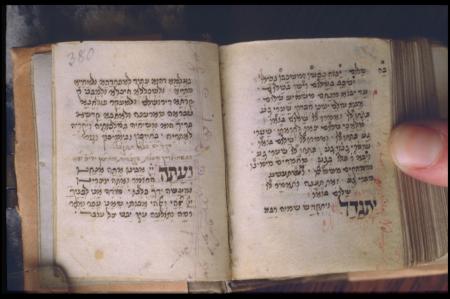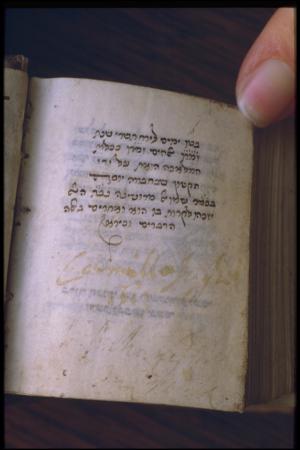Obj. ID: 1500
Hebrew Illuminated Manuscripts Joseph's Italian Siddur, Italy, 1492

The present manuscript is a siddur of the Roman rite for the entire year. According to the colophon (fol. 382v), it was copied on6 October 1492 (15 Tishrei [5]253) by Joseph b. Samuel of Rossano (a section of Canossa, in theprovince ofReggio-Emilia, Emilia).
The decoration of the manuscript was executed by two different hands. The first hand seems to be that of the scribe Joseph ben Samuel, who added some marginal drawings including four text illustrations, three of which are in the Haggadah for Passover, as well as simple pen decoration for letters and initial words (see: Decoration Program). Besides the evidence that the ink used for the decoration is very close to that of the script, the contact between the script and the decoration is particularly visible in those drawings stemming from the descenders of letters, such as on e.g. fols. 108v, 113v, 222 and 368.
The second stage of the decoration consists of many simple red filigree initial words panels (except for one executed in violet ink (fol. 380). This type of decoration was possibly rendered by another hand, which sometimes passes over the script, (e.g. fol. 86) and the brown-ink decoration; the styles, though both very simple, do not seem have done by the same hand. These pen-work flourishes, incorporating buds and foliage, are very common in Northern and Central Italy during the 15th century, and comparisons can be made with other manuscripts produced in Northern Italy such as from the 1490 mahzor at the JNUL, MS. Heb. 8 4450 and the appertaining second part in the Weill collection,Jerusalem (see: Metzger, 1976, No. 174 and fig. 10; Cohen, 1989, Kat. No. 46, fig. 81) that was written by Leon Yehuda bar Yehoshua (de Rossi) ofCesena. There are also similar forms in Biblioteca Ambrosiana inMilan, Ms. A 192 (see: Luzzatto-Mortara Ottolenghi, Tab. VII).
The same scribe, Joseph b. Samuel of Rossano copied five years later, in 1497, amahzor of Roman rite of which only the second volume survived (for Shavuot to Simhat Torah, Parma, Biblioteca Palatina, Parm. 3493; see: Richler cat. No. 943), sparsely decorated with similar "crude" style, such as the drawing of the arm and raised hand drawn on fol. 719). Joseph b. Samuel of Rossano is mentioned in two sale inscriptions found at the end of another manuscript: "Sefer Hashorashim" by David Kimhi, (Breslau - Juedisch-Theologisches Seminar 65, fol. 235v): in the first inscription he is recorded as the purchaser of the manuscript, in 12 December 1494, while in the following inscription, Joseph ben Samuel himself testifies he sold the manuscript on 18 June, 1495 to Joseph ben Judah of Ancona.
In conclusion, Cod. Hebr. 87 is a witness of the continued production of Hebrew manuscripts decorated by pen-work in Northern-Central Italyat the end of the 15th century.
sub-set tree:
Material: Parchment II + 384 + 1 leaves.
Easy to distinguish between hair side and flesh sides. (hair side is clearly evident on e.g., fols. 38v-39, 44v-45, 74v-75, 148v-149, 166v-167)
Measurements
|
Full page: 60 x50 mm |
|
Text space: 35 x (27-30) mm |
Scribes
|
Scribe A |
Main text |
Fols. 13-382v |
|
Later Scribe B |
Fols 1-12 |
Script
|
Written in semi-cursive Italian script in brown ink. |
Columns
Written in one text column
Number of lines
|
Main text written: |
in 13 lines in one columns for page |
Ruling
Ruling by ink for 13 horizontal lines only. Sometimes ruling for vertical lines (1 + 1) by plummet on both sides is discernable, e.g. fols. 51v, 55v, 64, 91v, 92, 104, 124, 197v, 239v
Pricking
No pricking is discernable
Quires
40 quires of ten leaves each except for: I2, II8+1 (fols. 5-11), VIII8 (fols. 62-69v), XII8 (fols. 100-107v), XXVIII6 (fols. 258-263v), XXXIX12 (fols. 264-275), XXX4 (fols 276-279v), XXXIV12-1 (fols. 310-320v), XXXV14 (fols. 321-334v), XXXVI8 (fols. 335-342v), XXXIX12 (fols. 363-374v)
Catchwords
Catchwords written horizontally in the lower left hand margin of the last verso of the quire, e.g. fols. 51v, 61v, 187v, 197v, 227v, 257v, 275v, 289v, 299v, 309v, 334v, 342v, 352v, 362v, 374v. Catchwords that are not discernable were probably cut out with the margins.
Hebrew numeration
None.
Blank leaves
Fols 383-384
Parchment on cardboard with blind tooled foliate frame. Metal strap and pin. Gilt and coffered. Yellow, green and black marble pastedown and both fly leaves.
The decoration program of the manuscript was rendered by two different hands. The first hand, possibly the scribe himself, executed many marginal drawings (e.g. fols. 30v, 74, 99v, 104v, 107v, 117v, 127v, 140, 147v, 157v, 162v , 167v, 171v, 185v, 190v, 207v, 217v, 222, 286, 325, 368), including four text illustrations, and word decorations in dark brown ink very close to that of the script (e.g.: fols.; 108v, 202; 202v, 203, 208v, 209). The second hand made many filigree initial word panels in red ink, and one in violet ink (fol. 380).
First Hand:
- I. Simple marginal drawings: hands (fols. 30v, 185v), one hand holding an unidentified object (fol. 162v), one holding a ribbon (fol. 222); one pointing to a flower (fol. 368); some drawings on top of initial words (e.g.: a dragon on fol. 209; some animals and drolleries on fols. 108v, 202; simple decoration: fols. 202v, 203, 208v, 209), other marginal drawings: a vessel (fol. 325); remnants of other marginal drawings cut out by the binder (e.g. fols. 74, 99v, 104v, 107v, 117v, 127v, 140, 147v, 157v, 167v, 171v, 190v, 207v, 217v); one decorated catchword (fol. 227v) by simple pen-drawing.
- II. Text illustrations: one hand raising a basket illustrating the text "הא לחמא", fol. 216; one hand holding the mazzah and one hand holding a bunch of lettuce leaves, illustrating the mazzah and the maror texts on fol. 227; one hand holding a feather illustrating the signing of the Judgment on New Year, on fol. 286);
- III. Decorated decenders: of letters kof (ק') (e.g. fols. 30v, 113v, 121v, 249v), final nun (ן) (e.g. fols. 113v, 124v, 382), final zadik (ץ) (e.g. fols. 116, 300, 367); and sign of the Name of the Lord (e.g. fols. 86, 121v).
- IV. Shaped text: three full-pages containing tow lines of text from the repetition of the Amidah of Musaf of New Year, written in X-shape (fols. 278-9) and one page with text written in the shape of a sand clock/hourglass (fol. 279v).
Second Hand:
- Initial word panels: decorating many initial words within the text in red ink, except one in violet ink (fol. 380). The panels are composed of three concentric red frames and decorated with flourishes extensions along the margins.



